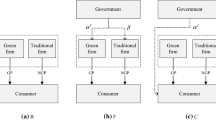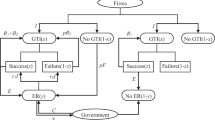Abstract
In this paper, we analyze the relationship between technological greening, eco-efficiency and no-regret strategies. By using a simple theoretical model we evaluate the effects of technological greening on creation value, pollution level, and eco-efficiency. We show three contrasting effects of technological greening. First, technological greening may increase the pollution of a firm, and also of the whole industry. Second, the indicator of eco-efficiency can be misleading because it may improve in situations where pollution increases and/or profit decreases after technological greening. Third, technological greening that induces an improvement of the eco-efficiency indicator does not necessarily lead to a no-regret strategy. As a result, the indicator should not be used for decision-making. These are the many traps of technology greening promotion.



Similar content being viewed by others
Notes
Introducing real dynamics in the model would make it much complex and would not add much to our main conclusions. The analysis is a short-term analysis because we take the firm’s heterogeneity as granted. Explaining why firms are heterogeneous is beyond the scope of the paper.
Parameters value are: p = 5, a = 0.5.
It belongs to the domain.
References
Berkhout PH et al (2000) Defining the rebound effect. Energy Policy 28:428–432
Boons F, Wagner M (2009) Assessing the relationship between economic and ecological performance: distinguishing system levels and the role of innovation. Ecol Econ 68:1908–1914
Brännlund R, Lundgren T (2010) Environmental policy and profitability: evidence from Swedish industry. Environ Econ Policy Stud 12:59–78
Bréchet Th, Jouvet PA (2008) Environmental innovation and the cost of pollution abatement revisited. Ecol Econ 65(2):262–265
Bréchet Th, Jouvet PA (2009) Why environmental management may yield no-regret pollution abatement options. Ecol Econ 68:1770–1777
Bréchet Th, Meunier G (2012) Are clean technology and environmental quality conflicting policy goals? CORE discussion paper 2012/6, Université catholique de Louvain
Bréchet Th, Michel Ph (2007) Environmental performance and equilibrium. Can J Econ 40(4):1078–1099
Callens I, Tyteca D (1999) Toward indicators of sustainable development for firms: a productive efficiency perspective. Ecol Econ 28(1):41–53
Coria J, Hennlock M (2012) Taxes, permits and costly policy response to technological change. Environ Econ Policy Stud 14:35–60
Cramer J, van Lochem H (2001) The practical use of ‘eco-efficiency’ concept in industry: the case of Akzo Nobel. J Sust Prod Des 1:171–180
Derwalle J et al (2005) The eco-efficiency premium puzzle. Financ Anal J 61(2):51–63
DeSimone LD, Popoff F (1997) Eco-efficiency: the business link to sustainable development. The MIT Press, Cambridge, MA
Ditz D, Ranganathan J (1997) Measuring up: toward a common framework for tracking corporate environmental performance. Technical report, World Resources Institute
Dowell G et al (2000) Do corporate global environmental standards create or destroy market value? Manag Sci 46:1059–1074
Erbas BC (2010) Factors affecting innovation and pollution-reduction performance of environmental regulations. Environ Econ Policy Stud 12:139–163
Greening A et al (2000) Energy efficiency and consumption—the rebound effect—a survey. Energy Policy 28:389–401
GRI (2006) Sustainability reporting guidelines. Technical report, Global Reporting Initiative
Guenster N et al (2010) The economic value of corporate eco-efficiency. European Financial Manag, no. doi:10.1111/j.1468-036X.2009.00532.x
Hart SL (1995) A natural resource-based view of the firm. Acad Manag Rev 20:986–1014
Huppes G, Ishikawa M (2005a) A framework for quantified eco-efficiency analysis. J Indus Ecol 9(4):25–41
Huppes G, Ishikawa M (2005b) Eco-efficiency and its terminology. J Indus Ecol 9(4):43–46
Jollands N et al (2004) Aggregate eco-efficiency indices for New Zealand—a principal components analysis. J Env Manag 73:293–305
King A, Lenox M (2002) Exploring the locus of profitable pollution reduction. Manag Sci 48:289–299
Lankoski L (2006) Environmental and economic performance. The basic links. In: Schaltegger S, Wagner M (eds) Managing the business case for sustainability. Greenleaf, Sheffield
Montalvo C (2008) General wisdom concerning the factors affecting the adoption of cleaner technologies: a survey 1990–2007. J Cleaner Prod 16(1):S7–S13
NRTEE (2001) Eco-efficiency indicators: how to measure eco-efficiency in business. Technical report, National Round Table on the Environment and the Economy, Canada
Palmer K et al (1995) Tightening environmental standards: The benefit-cost or the no-cost paradigm? J Econ Persp 9(4):119–132
Porter ME, Van Der Linde C (1995) Toward a new conception of the environment–competitiveness relationship. J Econ Persp 9(4):97–118
Rennings K, Ziegler A (2006) The influence of different characteristics of the EU environmental management and auditing scheme on technical environmental innovations and economic performance. Ecol Econ 57:45–59
Requate T (1995) Incentives to adopt new technologies under different pollution-control policies. Int Tax Public Fin 2(2):295–317
Requate T (1998) Incentives to innovate under emission taxes and tradeable permits. Eur J Pol Econ 14(1):139–165
Requate T, Unold W (2003) Environmental policy incentives to adopt advanced abatement technology: will the true ranking please stand up? Eur Econ Rev 47(1):125–146
Russo MV, Fouts PA (1997) A resource-based perspective on corporate environmental performance and profitability. Acad Manag J 40:534–559
Saling P et al (2002) Eco-efficiency analysis by BASF: The method. Int J Life Cycle Assess 4:203–218
Schmidheiny S (1992) Changing Course: A Global Perspective on Development and the Environment. The MIT Press, Cambridge, MA
Sinkin C et al (2008) Eco-efficiency and firm value. J Account Pub Pol 27:167–176
Sturm A et al (2003) Eco-efficiency indicators conceptual framework and guidelines. Technical report, UNCTAD
Telle K (2006) “It pays to be green”—a premature conclusion? Environ Res Econ 35:195–220
Verfaillie HA, Bidwell R (2001) Measuring eco-efficiency: a guide to reporting company performance. Technical report, World Business Council for Sustainable Development
WBCSD (2000) Eco-efficiency: creating more value with less impact. Technical report, World Business Council for Sustainable Development
Acknowledgments
Preliminary versions of this paper were presented at the Environmental Meeting at CORE, at the research seminar of CRECIS, Louvain School of Management, at the Rencontres de l’Environnement organized by CORE–EUREQua–EconomiX–EQUIPEE, at the EAERE-09 (Amsterdam) and at the European Academy of Management 2010 (EURAM at Rome). We are grateful to the editor of the journal, an anonymous referee, Paul Belleflamme, Maria-Eugenia Sanin and Thierry Lafay for their comments and suggestions. The paper was finalized while Th. Bréchet was visiting research fellow at the Grantham Institute for Climate Change at Imperial College London, and visiting professor at the European University at St Petersburg, Russia.
Author information
Authors and Affiliations
Corresponding author
Appendices
Appendix 1: Proof of Lemma 1
The effect of technological greening on profit is given by the first derivative of the profit level (2) with respect to the technological parameter b i . Let us define the following:
This \(\varphi_i\) function allows us to define a frontier on which the effect of technological greening on the profit level is zero, \(\varphi_i^{*}(b_i,t)=0. \) There exist cases where real roots of \(\varphi_i^{*}(b_i,t)=0\) do not exist. The very existence of real roots for \(\varphi_i^{*}(b_i,t)=0, \) denoted by \(\underline{t}_i\) and \(\bar{t}_i, \) relies on the following assumption:
Assumption
We suppose a condition on a for which an environmental technological amelioration allow an improvement of the profit level. Otherwise \(\underline{t}_i\) and \(\bar{t}_i\) do not exist which means an environmental technological amelioration decrease the profit level.
Both of the roots belong to the set domain, \(\bar{t}_i<\tilde{t}\) and \(\underline{t}_i<\tilde{t}.\) For b i = 1, we have:
Calculating the first and the second derivatives of the function \(\underline{t}_i=\frac{1}{2}(b_ip-\sqrt{b_i^{2}p^{2}-8ab_i^{4}}),\) we determine that the curve is increasing and convex to the origin.
Calculating the first and the second derivatives of the function \(\bar{t}_i=\frac{1}{2}(b_ip+\sqrt{b_i^{2}p^{2}-8ab_i^{4}}), \) we determine that the curve is decreasing and concave to the origin.
Appendix 2: Proof of Lemma 2
The effect of technological greening on pollution is given by the first derivative of the emissions (1) with respect to the technological parameter b i which is given by:
The function \(\tilde{t}_i\) is linear and increasing in b i .
2.1 Location of the frontier within the set domain
A frontier \(\tilde{t}_i=\frac{b_ip}{2}\) is defined such that the effects of technological greening on pollution level is null: ψ * i (b i ,t) = 0. Under our assumption this function of iso-emissions (\(\tilde{t}_i=\frac{b_ip}{2}\)) belongs to the set domain \(\tilde{t}_1<t_1 \quad \Leftrightarrow \quad p/2<p. \) The function \(\tilde{t}_i=b_ip/2\) is located above the frontier \(\underline{t}_i=\frac{1}{2}(b_ip-\sqrt{b_i^{2}p^{2}-8ab_i^{4}})\) for b 1:
2.2 Crossing point
The function \(\tilde{t}(a, b_i, p)\) crosses the roots \(\bar{t}\) and \(\underline{t}\) at a particular value of b i such that \(b_i=\frac{p}{\sqrt{8a}}:\)
Appendix 3: Proof of Proposition 2
The effect of technological greening on the eco-efficiency indicator is given by the first derivative of I i w.r.t. b − i,
The function \(\breve{t}\) is increasing and concave in b i and equals zero for \(b_i=p/(2\sqrt{a}). \)
3.1 Location of the frontier within the set domain
The frontier \(\breve{t}_i=\frac{b_ip^2-4ab_i^3}{p}\) is such that the effect of technological greening on eco-efficiency indicator level is nill, \(\Uplambda_i^{*}(b_i,t)=0. \) This function \(\breve{t}_i=(b_ip^2-4ab_i^3)/p\) belongs to the set domain
The function \(\breve{t} = (b_ip^2-4ab_i^3)/p\) for b i = 1 gives us \(\breve{t} = (p^2-4a)/p\) and it is located between \(\bar{t}_1\) and \(\tilde{t}_1. \)
Assuming that a < (p 2)/(8b 2 i ) allows us to set a condition on p for b 1. It confirms that \(\bar{t}_1 >\breve{t}_1: a <(p^2)/(8b_i^2) \quad \Leftrightarrow \quad p>\sqrt{8a}. \) Considering this assumption on a we can also confirm that \(\breve{t}_1>\tilde{t}_1: \quad \Leftrightarrow \quad (p^2-4a)/p>p/2 \Leftrightarrow p>\sqrt{8a}.\)
3.2 Crossing point
The function \(\breve{t}(a, b_i, p)\) crosses \(\tilde{t}(a, b_i, p)\) and thus \(\bar{t}(a, b_i, p)\) and \(\underline{t}(a, b_i, p)\) at \(b_i=p/(\sqrt{8a})\) (see Appendix 2) such that
About this article
Cite this article
Bréchet, T., Ly, S. The many traps of green technology promotion. Environ Econ Policy Stud 15, 73–91 (2013). https://doi.org/10.1007/s10018-012-0035-5
Received:
Accepted:
Published:
Issue Date:
DOI: https://doi.org/10.1007/s10018-012-0035-5




